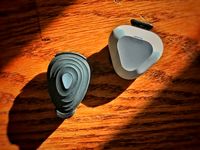Running Power Meters
Power meters have become an integral part of training for cyclists, and a number of running Running Sensors claim to have similar benefits for runners. I find myself unconvinced and I doubt if they'll have the same impact on running that they have on cycling. However, while they have some significant flaws, I suspect that if you understand their limitations they may still be useful. Let's start with the differences between power for cycling and running.
- The amount of energy required to run a given distance on level ground is fairly constant, which means that for runners, pace is often an excellent estimate of effort. By comparison, the effort required for cycling varies with the square of speed and is impacted far more by wind speed and aerodynamics, so speed is fairly useless.
- For cyclists, it's easy to define power output, as it's the energy used to propel the bicycle forward. For runners, it's far less obvious what should be considered power. You could consider it purely to be the horizontal force applied to the ground, as that's the only power that goes towards forward movement, but that's only a tiny fraction of a runner's energy expenditure. Much of a runner's energy expenditure goes to vertical movement, but some of that movement is elastic balance, and some of it requires energy. That means that defining power output for a runner is tricky at best.
- It's quite easy to measure cycling power by measuring the force applied (torque) and the rotation it's applied through. This makes cycling power meters reasonably accurate and not outrageously expensive (compared with say, a metabolic cart that a lab would use to measure oxygen consumption). By comparison, running power is impractical to directly measure and requires a mathematical model with various assumptions that use indirect inputs. This makes running power meters an estimate of power output rather than a true meter. If cycling power meters worked like this, they'd be a wind speed meter that would guess how that influence power output.
- Because running is vastly less efficient than cycling, knowing power output is less important. If a cyclist knows their power output, they have a very good estimate of their exercise intensity. This is because most of a cyclist's effort is delivered as usable power. Even if it were practical to measure running power, it would be of relatively less value due to the influence of Running Economy. This means that a runner is far more interested in their energy expenditure than of their power output.
This doesn't mean that running power meters are useless. If you understand their limitations, they may still be worthwhile. It's possible for a running power meter to estimate how an incline or decline might change exercise intensity for a given pace. This would allow for more even pacing on hilly courses, allowing for a more even effort when training. More importantly, it could allow for more even pacing on a hilly race, which would be great for things like the Boston Marathon. This could be more effective than Heart Rate, which suffers from a significant lag between changes in intensity and a change in Heart Rate, as well as Heart Rate Drift. I've tested the Stryd which gives some usable estimates of power, and SHFT which was fairly useless in its power estimate. The ideal solution would be a way of estimating oxygen consumption, but so far, the only option is a hugely expensive and hugely inconvenient metabolic cart.
